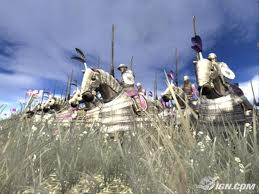|
The Roman army in the earlier period had been the infantry. Cavalry had been the province of foreign auxiliaries to begin with, and even when better established had only very specific and limited roles. Towards the end of Late Antiquity the empire faced new threats, and the army confronted unfamiliar military methods. Primary amongst these was the increased use of cavalry amongst Rome's enemies, and not just any cavalry, but heavily armoured horsemen riding armoured horses equipped with stirrups. The army lost no time in fully matching these eastern cavalry techniques.

The Byzantine Empire will need to regain its losses to the Turks in Asia Minor as well as the regions lost to internal strife, before it can expand into other faction' s territories. Fortunately the Seljuks, as well as the Egyptians, are more focussed on the Crusader States; but should they fall the Byzantines are unlikely to withstand a united Islamic offensive.

As such, some cooperation with the Crusader States will be necessary for the Empire's wellbeing. The Byzantine Empire was created on the back of a strong military tradition, although much smaller than in the past, the Empire's forces tend to be well trained and disciplined. The Empire's forces consist of a wide range of unit types, from heavy cavalry to infantry, and many ranged units including the devastating Greek Flame Thrower.
Used throughout the Byzantine Empire to protect merchants, provincial towns and roads, Militia Cavalry are poorly trained and armoured in light mail armour and equipped with a spear. These men are very good at chasing down archers and light infantry and light cavalry.

The Byzantine cataphract was armed with bow, lance, sword, and dagger; he wore a shirt of mail or scale armour and an iron helm and carried a small, round, ironbound shield of wood that could be strapped to the forearm or slung from the waist.
The foreheads and breasts of officers' horses and those of men in the front rank were protected with frontlets and poitrels of iron. The militia cataphracts were backed by units of similarly armed regulars and mercenary regiments of Teutonic heavy shock cavalry of the imperial guard. Mercenary horse archers from the steppe continued to be used as light cavalry.
By the time of the so-called Byzantine era (the surviving eastern Roman Empire) true power on the battle field had long since passed into the hands of the cavalry. If there was any infantry, it was made up of archers, whose bows had longer range than the smaller bows of the horsemen. Handbooks were published, most famously by the general and later emperor Maurice (the strategicon), the emperor Leo VI (the tactica) and Nicephorus Phocas.
|

![]()


